The Bonus Round is one of the gameplay elements on Wheel of Fortune. The Bonus Round has had several variations over the show's long history.
Shopper's Special[]
Used only on the Shopper's Bazaar pilot, the puzzle was the name of the prize the contestant was playing for. The winner was shown all vowels in the puzzle, then had 30 seconds to give one correct consonant and solve the puzzle.
While this particular format was only used in 1973, the concept was eventually recycled into the Prize Puzzle (albeit much less straightforward most of the time).
Star Bonus[]
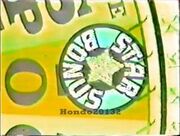
A token which covered a low-value wedge (the orange $100 next to Free Spin in Round 1, the tan $100 in Round 2, and $150 in Round 3) and allowed the player who picked it up to play a special puzzle at the end of the show. It could not be lost to Bankrupt nor forfeited by failing to solve that round's puzzle, and landing on it resulted in a "Charge" fanfare playing.
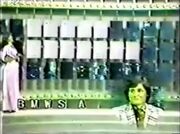
In the Star Bonus Round, the contestant chose one of four prizes, with the difficulty of the puzzle corresponding to the prize's value (Easy, Medium, Hard, Difficult). The puzzle was shown, and the player chose four consonants and a vowel. After the correct letters were revealed (if any), s/he was given the category and 15 seconds to solve; an onscreen "stopwatch" graphic served as the timer.
The Star Bonus was only used for a brief period in 1978: it debuted at some point between March 15 and April 6, and was gone by about early July (one 1978 episode has Chuck joke "there goes my Emmy", referring to that year's Daytime Emmy Awards where he was nominated but didn't win, suggesting it was taped after the nominations were announced but before the winners were named). Per one recollection, the Star Bonus was used for just three or four weeks.
There are three known instances of the Star Bonus being played: two Difficults and a Medium. One was played on April 7 by veteran game show contestant Scott Hostetler (see right), who failed to solve PABLO PICASSO (Difficult). According to a recollection, the other puzzles were TOSSED GREEN SALAD (Medium) and KNOCK ON WOOD (Difficult), with RSTNE picked for both. Per Scott's own recollection, he was the second person to play the Star Bonus Round.
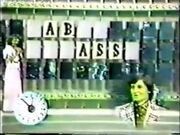
Star Bonus was likely retired for several reasons, the most obvious being that there was no guarantee it would be played. If it was not picked up, it was removed to play Round 4 (presumably only if there was time for further rounds); if it was picked up, the game ended after Round 3. Further, while the prizes designated for the Star Bonus were marked by stars, they could also be purchased during normal shopping rounds, allowing for the possibility of a come-from-behind win being negated or even rendering the token entirely useless due to having no prizes to play for. It likely also had a detrimental effect on the show's end product: the April 7 episode is heavily edited, most noticeably the contestant interviews, seemingly to provide enough time for the Star Bonus Round.
On the June 26, 1978 episode of Match Game (taped May 26), when host Gene Rayburn begins to explain about landing in a "gold star area" on the Star Wheel (which debuted that day), panelist Richard Dawson jokes that "Chuck Woolery comes out and punches you in the mouth." The timing of Dawson's comment and his namedrop of Woolery point to this being a reference to the Star Bonus, which if so would be the only known reference to it contemporary media.
Current Bonus Round[]
Five-and-a-Vowel[]
The most familiar Bonus Round was tested on a few episodes in 1981, but does not appear to have become permanent until early 1982. Its first known appearance was during Second Honeymoon Week (July 13, 1981), and it was used again during Christmas Wish Week (December 14, 1981) as well as Pat Sajak's first week (December 28, 1981), but not on Chuck Woolery's last episode the previous Friday (December 25). The weeks of March 22 and 29, 1982 were referred to as Bonus Week, suggesting that it was still not a permanent part of the show; it was likely made permanent by June 1982.
Originally, the contestant was provided a blank puzzle and a category, and asked for five consonants and a vowel. S/he then had 15 seconds to solve. Almost all contestants chose some permutation of R, S, T, L, N, and E as those letters are the most common.
As with the Star Bonus, the winner originally played from their spot at the contestant area. The current setup, where the winner stands in front of the Wheel, was likely introduced around the time the round became a permanent part of the show, and definitely by its appearances in mid-June 1982.
Originally, contestants could pick any prize marked with a gold star to play for in the Bonus Round, which sometimes resulted in playing for a fairly inexpensive item such as a piece of furniture. With the nighttime change to play-for-cash in October 1987, that Bonus Round began offering 5-6 different prizes: $25,000 cash, a car, and 3-4 other prizes that changed each week. The vast majority of contestants chose either the cash or a car.
By about 1985, nearly every contestant began calling some permutation of RSTLNE, which tended to reveal a good portion of the puzzle more often than not.
According to a tweet by Pat in 2022, the name "Bonus Round" was a placeholder, and stuck only because the producers could not think of anything better.
Three-and-a-Vowel[]
The current rules were introduced on the nighttime show on October 3, 1988 and on the daytime show at some point in September or October of that year. The player is now given RSTLNE, then asked for three more consonants and a vowel (plus a fourth consonant if s/he has a Wild Card). The time limit was reduced to 10 seconds, and the puzzles were made slightly harder.
It is extremely rare for RSTLNE to reveal half or more of the answer, and many puzzles between 1991 and 1996 used none of those letters. Starting in Season 7, bonus puzzles also became much shorter: under the original rules and the majority of Season 6, bonus puzzles were often 15-20 letters long (and in some cases, were even the longest puzzles of the episode), while the vast majority from 1989 onward were typically between 4-10 letters (including several that were only 3 and, sometime during Season 11, the 2-letter AX). The practice of very short bonus puzzles was gradually reversed around 2004-05.
In Season 6, the show tried two experimental "Wipe Out" Weeks (October 24-28 and February 13-17), where winning the game allowed the contestant to return the next day, but also eliminated the bonus prize that they played for if it was won. To indicate this, red "WO" letters were placed on each prize that was won. These episodes are also notable for playing a snippet of "Wipe Out" by the Surfaris whenever a Prize was won.
W-H-E-E-L Envelopes[]
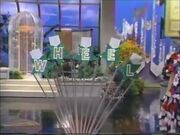
The envelopes in 1990...
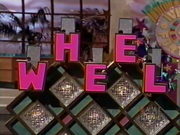
the mid-90s...
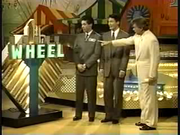
...and September 1997.
The prize selection was changed at the beginning of Season 7 (September 4, 1989) to a random draw from five envelopes spelling out W-H-E-E-L, and any prize that was won was taken out of rotation for the rest of the week. This change was likely done because an overwhelming majority of contestants during Season 6 chose to play for the $25,000. On Fridays, if only one envelope remained, Pat generally said what the remaining prize was but still had the contestant pull out the envelope anyway. Regardless of outcome, Pat always revealed the prize after the round, except on the envelopes' first day.
While daytime added a $5,000 cash prize on Bob Goen's debut (July 17, 1989), players were still allowed to choose their prize, though choosing the cash or car was somewhat less common than it had been on nighttime. Wheel 2000 used just two envelopes (A-B), with the prize only revealed if it was won.
While the envelopes have changed very little over the years, the prop they were housed in had seven distinct appearances:
- Originally, the W-H-E-E-L envelopes were spelled out on five green stars, with the letters in silver at the end of thin metal poles, all on a small 12-wedge Wheel-shaped platform like the one seen here.
- Sometime between September 11, 1990 and January 1991, a large gold ring was added behind the poles.
- For the weeks of September 7 and 14, 1992, the 12-wedge Wheel platform switched to this.
- The prop was overhauled on September 21, 1992 to display the letters (now pink, with lights) in a zig-zag on a diamond-esque lighted frame, with a black base underneath. When an envelope was selected, a chime rang as the chosen letter's light turned off (a high-pitched ding at Television City, a lower-pitched ding on road shows), although the high-pitched ding was not used for the first eight weeks of Season 10 and discarded completely at the beginning of Season 13. The lights flashed if the puzzle was solved.
- For some road shows and other special theme weeks, the letters were changed to red.
- For the Arizona episodes of Season 14 (February 10-21, 1997), the prop was redone in turquoise and red with a pattern resembling a Navajo weaving.
- The prop was then overhauled on February 24, coinciding with the new electronic Puzzle Board and the name tag design change. It now used green letters and gold rectangular lights similar to that of the new touch-based puzzle board.
- When Season 15 began on September 1, 1997 at the Ohio State Fair, the prop was slightly altered to put the W-H-E-E-L lights in a horizontal line.
- Just two weeks later when Wheel returned to Culver City (September 15), all lights except the W-H-E-E-L ones were removed from the prop, as were the green center and black base. The letters now sat on a transparent square base with an abstract design on the front.
For several weeks during Season 14, the prize envelopes' insides were glittery green instead of their usual gold design. In addition, there was a separate battery-operated $25,000 envelope with flashing numbers, which Vanna would hold up in promotion of that prize. For a brief period around Season 17, the $25,000 envelope had the show's logo on the inside of the top flap; this was reverted sometime in Season 18.
Beginning on September 21, 1998 (two weeks into Season 16), the $25,000 envelope was kept in play even if won. On September 3, 2001 (the first show of Season 19), the prize selection was changed to three different cars and two $25,000 prizes, all of which remained in play all week; this was also the point at which the Bonus Round generally stopped offering anything other than cash or cars. Previously, contestants could win gold-and-silver packages, jewelry, annuities, trips, boats, trailers, motorhomes, or other esoteric prizes.
The most expensive Bonus Round prize in the W-H-E-E-L era was a custom-built Shelby Cobra worth over $105,000, won by Derek Rose on a Las Vegas episode in February 1998.
Bonus Wheel[]
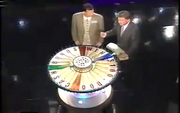
The original Bonus Wheel.
Despite the three-car/two-$25,000 setup being touted as a new change "for the season", the five-envelope format was replaced on October 22, 2001 (eight weeks into Season 19) with a 24-envelope Bonus Wheel. Other than a single $100,000 envelope, the prize distribution has changed over time:
- Originally, there were 11 $25,000 envelopes and 12 car envelopes, whose distribution varied depending on whether a week offered two or three cars.
- In February 2002, additional cash amounts (one each from $30,000-$50,000 in $5,000 increments) were added for Big Money Week, a configuration made permanent that September.
- For the NASCAR Week of April 22, 2002, a lifetime supply of gasoline from 76 (valued at $60,000) was available.
- With the introduction of the Million-Dollar Wedge in Season 26, the $100,000 envelope is replaced with a $1,000,000 one if the contestant takes the wedge to the Bonus Round. Said envelope originally had a design identical to the graphic on the wedge, but by February 23, 2009, it became "ONE MILLION" (with the latter word in much larger letters) in plain black text.
- Also starting with Season 26, only one car is offered in the bonus round.
- Starting with a special week of episodes aired in July 2009 (the Season 26 finale) and running through November 27, 2009 the following season, the Bonus Round temporarily stopped offering cars. The week of December 21, 2009 also did not use cars due to being taped out of order. During this period, the car envelopes were likely replaced with additional $25,000 envelopes.
- In Season 28, the cash minimum increased to $30,000, and cars began to include a $5,000 cash bonus.
- In March 2012, additional cash amounts of $65,000, $75,000, and $85,000 were available for Big Money Week, although none of them were landed on and the envelopes were never shown on-air.
- In the unaired 2012 "Lottery Experience" games, the car's cash bonus was $15,000 instead of $5,000.
- From November 25, 2013 through the end of Season 31, the cash awarded with cars was dropped to $3,000.
- In Season 32, $30,000 and $35,000 were both retired (although the latter returned for Season 35); the lowest value is now the current season number multiplied by $1,000. For this season, the cash award with cars reverted to $5,000, and the envelopes of such read "CAR & $5,000" on the inside.
- In Season 33, the cash awarded with cars was removed entirely, and cars valued less than the cash minimum became more common.
- In Season 35, $40,000 was retired (although this amount returned permanently for Season 40), currently leaving only the cash minimum, the car (or other vehicle), $45,000, $50,000, and the $100,000 (or $1,000,000).
- On Home Sweet Home weeks in Season 38, a $375,000 house in a Latitude Margaritaville 55+ community of the winner's choice was available in the Bonus Wheel. One "Home" envelope was available by default, and a second available if the contestant took the Home Wedge to the Bonus Round. The "Home" envelope replaced the show's logo with that of Latitude Margaritaville and read "HOME" on the inside. It is unknown which prize the second "Home" envelope would replace. During these weeks, the $100,000 or $1,000,000 is still available.
- During several weeks of Season 40, the XL Wedge was present on the Wheel, in honor of the nighttime show's 40th season. If taken to the Bonus Round, this wedge offered an additional $40,000 cash in addition to the existing bonus prize if won.
- In Season 41, the annual increase in the cash minimum was discontinued, leaving $40,000 as the minimum amount, while $75,000 became available permanently.
As with the W-H-E-E-L envelopes, Pat always reveals the contents after the round regardless of outcome. For the first few weeks, he also revealed the location of the $100,000 envelope. Likewise, since the introduction of the $1,000,000 prize, Pat always reveals its location, barring a January 2009 episode where he forgot. Pat's cards include a diagram of the Bonus Wheel with the $100,000 or $1,000,000 envelope's location colored red. This can occasionally be seen on camera. Likewise, Vanna is given signals from offstage if either top prize is hit. On Celebrity Wheel of Fortune, all four $100,000 locations are colored red on Pat's card, and if the $1,000,000 is in play, its location is colored green.
Like the W-H-E-E-L envelope prop, the Bonus Wheel has had several different appearances:
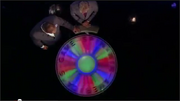
Seasons 26-30.
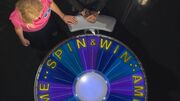
The current Bonus Wheel.
- Originally, it spelled out "WIN $100,000 CASH BONUS" in red with colored spaces between the words (blue after "WIN", orange after "$100,000", green after "CASH", red after "BONUS") and the traditional logo (with colors on its "wedges") on the center, which itself did not spin.
- On October 29, a large domed light replaced the logo and the red wedge became purple. Despite this, the original version appeared a few more times during the season due to episodes being taped out of order.
- At the beginning of Season 21, the lettering was changed to blue. The solid-color wedge after "$100,000" became green, the one after "CASH" became purple, and the one after "BONUS" became pink.
- The prop became neon at the beginning of Season 22, with the solid-color wedges replaced by stars (one after "WIN", two after "$100,000", three after "CASH", four after "BONUS").
- In September 2008, the words changed to "AMERICA'S GAME SPIN&WIN" with a one-star space after "AMERICA'S", a two-star space after "GAME", and a three-star space after "WIN". Also, neon rings were added to the base.
- At the beginning of Season 30, the rings on the base began to flash as the Bonus Wheel was spun.
- At the start of Season 31, the Bonus Wheel became a darker blue and purple with yellow characters, and the three-star space was changed to have its stars form a triangle instead of a horizontal line. In addition, the selected envelope now has its wedge turn light blue as the envelope is pulled. On November 5 and 7 only (both America's Game episodes), the lighting was altered so that the wedges flashed red, white, and blue when the Wheel was spun. During the Secret Santa Sweepstakes (November 11-27), it inconsistently flashed red and green.
Starting in Season 23, the Bonus Wheel remains onstage for the final segment; prior to this, it (like the W-H-E-E-L props before it) was taken offstage at the final break.
Despite a timer being present in the studio, it was very rarely shown on-camera and never appeared during the Bonus Round itself. A visual timer was added to the contestant window at the beginning of Season 30.
The $100,000 and $1,000,000 envelopes both have the two-row Wheel of Fortune logo on the upper flap, while the other envelopes use the traditional logo. Some $100,000 winners have reported getting to keep said envelope as a souvenir.
While it has never been stated on-air, the Bonus Wheel must make at least one complete revolution; spins that do not are edited out.
On Celebrity Wheel of Fortune, there are only four cash prizes by default: $25,000, $50,000, $75,000, and $100,000, the last of which has four envelopes, with one of them being replaced with $1,000,000 if the winner of that half has the Million-Dollar Wedge. Unlike the main show, where the cash prizes are less frequent the higher they are in value, it is likely that the $25,000 prize is less frequent than $50,000 and/or $75,000, as it was never landed on during the first season of the show. In addition, all envelopes, including the $1,000,000 one, have the traditional logo.
Unlike the old envelope ding, the current chime is in fact the beginning of the cue that plays immediately after the envelope is pulled out. The old ding is still used after each episode's production slate is read, a practice dating back to at least January 1997.